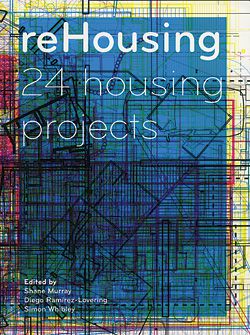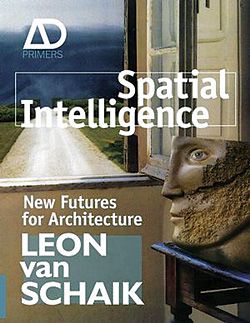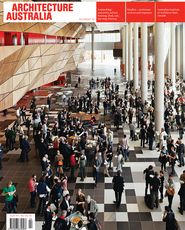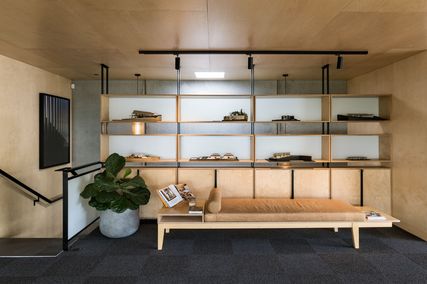ReHousing: 24 Housing Projects

Edited by Shane Murray, Diego Ramirez-Lovering and Simon Whibley. RMIT University Press, 2008. 135pp. RRP $35.
This useful, smart publication extends the reHousing conference organized by the authors in 2006, and is part of a larger, significant body of research being undertaken by Shane Murray and colleagues into housing and how architecture might contribute to everyday domestic environments.
Murray’s opening essay lucidly sets out the complex issues at play in architecture’s relationship to general housing – the massive demographic shifts, the nature of the existing housing industry, and the relationship between architecture and dwelling. He points to the idea that redefining housing involves rejecting architecture’s “obsession with the dwelling as an object”, and pursung instead “an examination of the conditions shaping its performance,” and observes that this expanded definition still requires architects to conceive and realize physical environments, and thereby use the profession’s fundamental skill – design. Indeed, there is a great deal of knowledge already embedded in the profession, in both contemporary and historical housing projects, but little work has been done to reveal this embodied knowledge or to find ways to effectively disseminate it.
The presentation of 24 projects in this volume is a strong starting point, revealing a rich array of design work and ideas that might be drawn on when considering general housing. The projects are presented in three groups, each framed by an essay – Simon Whibley’s “Trojan Houses” on housing design strategies that have an effect “beyond the limits of site and brief”, Peter Richard’s “Suburban Urbanism” on developing settlement types that aim to produce robust, socially diverse communities, and Diego Ramirez-Lovering’s case study of the Sustainable and Affordable Home initiative. Altogether, this is an impressive and important volume, which suggests great promise while also pointing to the large amount of work to be done.
Justine Clark
Spatial Intelligence: New Futures for Architecture

Leon van Schaik. John Wiley & Sons, 2008. 208pp. RRP $64.95.
In this book, Leon van Schaik has painstakingly uncovered the hidden mystery of spatial intelligence in architecture and urbanism. He has also highlighted the serious deficiencies in current architectural theories and practices. He provides fascinating, exciting and critical analysis of many key Western architectural theorists and critics. With a great sense of urgency and intellectual passion, van Schaik challenges architects to re-examine and redefine their present restrictive professional and educational goals, and to vigorously pursue new visions and ethical responsibilities through effective applications of spatial intelligence.
Spatial intelligence is one of the inherited human capabilities. It is firmly rooted in the subconscious of individuals and collective histories of communities. People use their spatial intelligence unconsciously all the time in their daily lives. However, its manifestations in dreams and sleep are usually blurred and cannot be easily codified. Van Schaik has drawn our attention to the incredible collective recall of “distributed intelligence” of Aboriginal art in Australia. Clearly, we have just begun to understand the complex inherited characteristic of spatial intelligence, as we have yet to provide an explanation of the homing pigeons from a long distance away. Another dilemma which will require further investigation is how Asians such as Chinese with music intelligence living in their own cultural environment can comprehend Western classical music and perform at an international level. Can the inherited genetic elements over many millenniums be enjoyed across cultural frontiers by everyone?
After WWII, modernism has been restructured and hijacked by American multinational corporations as an effective tool for their overseas business expansion. Aesthetic standardization has drastically compromised and reduced the applicability of cultural and site-specific design projects such as those of Frank Lloyd Wright and Alvar Aalto. Cities are treated as if they are interchangeable, and design statements of their buildings are transferable anywhere. In subsequent decades, many have vigorously contested this phenomenon of modernist ideologies without much success, as Western societies are dominated by the shadow of greed, quantity and universality. The reviewer strongly advocates the need to critically examine the guiding principle of architectural modernism in the careless destruction of the old and the attitude of temporariness towards the present, as cities should be evolved and developed by carefully layering over the past mental space in order to strengthen spatial memories of citizens over time.
Van Schaik has clearly understood that “there is much to be learned from examining the spaces, designed and made by people fully integrated into the communities for which they were created in pre-modern times or, in post-modern times” (p.97). His reference to the Yong Kung community in Taipei, as an example, should lead to a deeper discourse of Asian urbanism, where many Asian cities today experience the environmental shock of pre-modern, modern and postmodern conditions simultaneously and in a compact hybrid of contradictions. The dynamic, exciting and chaotic Asian cityscape includes increasing recognition of the essentiality of spaces of indeterminancy or Ignasi de Solà-Morales’s “terrains vagues”, which should generate incredibly challenging alternative urbanism and broaden our understanding of spatiality.
I am greatly impressed by and have little to add to van Schaik’s complex comprehensive analysis and visionary recommendations for new futures for architects and challenging professionalism in the last two chapters of the book. These should be read carefully as they offer fascinating insights, particularly for those with a strong, active commitment to participate in the new real and virtual mental space generated by conscious applications towards their own continuously evolving and developing spatial intelligence and other accompanying capabilities.
William Lim















